PEARLHARBORMIDWAYJA





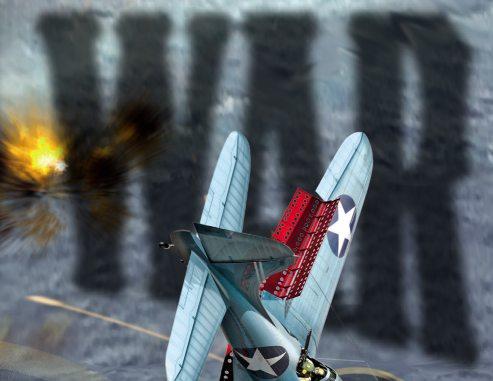
































 By Jack Harrison
By Jack Harrison


HOWTHE UNITED STATES FOUGHTBACK
1942 – 2017 M A R K I N G THE 75thANNIVERSARY OF THEBATTLE O F M I D W YA R
APANESESURRENDER
AUTHOR: Jack Harrison jharrison@mortons.co.uk
PAGE DESIGN: CraigLamb design_lamb@btinternet.com
COVERDESIGN: Justin Blackamore
COVERARTWORK: John Fox www.design-phoenix.com
PRODUCTION EDITOR: DanSharp
REPROGRAPHICS: Paul Fincham
Jonathan Schofield
ADVERTISING: Martin Freeman mfreeman@mortons.co.uk
MARKETINGMANAGER: CharlottePark
COMMERCIAL DIRECTOR: Nigel Hole
PUBLISHINGDIRECTOR: DanSavage
PUBLISHER: SteveO’Hara
Images marked ✪ areinthe public domain Images marked ✱ are published undera CreativeCommons License, creativecommons.org
PRINTED BY: WilliamGibbons andSons, Wolverhampton
ISBN:
978-1-911276-35-7
PUBLISHED BY: Mortons MediaGroup Ltd, MediaCentre, Morton Way, Horncastle, Lincolnshire
LN96JR
COPYRIGHT:
Mortons MediaGroup Ltd 2017 allrightsreserved.
CONTENTS
Acknowledgements
Theone-linementionsabove do notdo enough justicetothosewho have used theirconsiderableskills andtalents to help producethis 132-page edition that yousee before you.
Starting, quiteliterally,from thefront andIcannot speakhighlyenough aboutthe superb work of coverartistJohnFox (www.design-phoenix.com). In all the research Ihaveundertaken for this volume, Ihaveseenfew better artistic depictions of theBattleofMidway. He has trulymanaged to bringthe past to life.
Imustalsothank theefforts of designers Craig Lamb (pages)and JustinBlackamore (cover), as well as production editor Dan
Sharp whohaveall been instrumental in bringing my chosenwords andimages together.AshavePaulFincham and Jonathan Schofield;workingwith75-yearold photographyisachallenging task for even themostskilled picture desk,and they have certainly done theincredible range of material availablethe justiceitdeserves. Anditwouldalsoberemissofmetonot mention thefriends, familyand lovedones whohaveencouragedand supportedthe researchand writing involved in thisproject. It’s been agreatprivilegetopresentthis fascinating story, butit’scertainly nota oneperson job. My thanks to everyone whohas played apart.
Pacific War3 008 CHAPTER 1 ThePacificTheatre 010 CHAPTER 2 On theroadtowar 018 CHAPTER 3 Theday of infamy 040 CHAPTER 4 TheSouthern Resource Area 046 CHAPTER 5 Critical Japanese mistakes 052 CHAPTER 6 Reaction and retribution 062 CHAPTER 7 America’sfightback 064 CHAPTER 8 Americacracks thecode 066 CHAPTER 9 Thebattlelines aredrawn 070 CHAPTER 10 From CoralSea to Midway: America turnsthe tide 108 CHAPTER 11 ThePacificWar afterMidway 114 CHAPTER 12 Asymbolicbattle in theskies 122 CHAPTER 13 Submarinewarfare 124 CHAPTER 14 Allied offensives 128 CHAPTER 15 Resistance and surrender No part of this publication maybeproducedortransmitted in anyformorbyany means, electronicormechanical, including photocopying,recording,orany information storageretrieval system withoutprior permission in writingfromthe publisher.
Flagship Akagi under attack




ON THE COVER
Artwork: John Fox

Pacific War
The Battle of Midway.Mosthaveheard of it,manyknowitasaturningpoint of thePacificWar.But howdid this major engagement,pitting theinexperienced US Navy againstthe battle-hardened Japanese sea forces,cometobesucha significant chapter in thehistories of both nations?Itismyaim to shed some lightonthe answer in the132 pages of this volume.
Afterthe PacificWar burstexplosively into beingonDecember7,1941, Japanenjoyed near-total domination in thevastTheatre for aclear sixmonths–and it wasnofluke. Japan had emerged from theGreat Warof19141918 as one of thefew ‘winners’, having used theconflict to enhanceits ownaimsofAsian dominancebytakingcontrol of territory from Germany. It had nowpositioned itself as the keypower in theAsia-Pacificregion,and both Europe andAmerica wouldneedtotakenotice. Whilethe complexweb of treaties that followed thewar were intendedtoprevent furtherviolenceand quell global militarism, they flounderedinthe face of worldwide economic turmoil, resource shortages, and othercrisessuchasthe devastatingSpanish flu pandemic. AndalthoughmuchofEurope andthe US were keen to embark on aperiod of peace, Japanremainedfar moreopento thefinancialand territorial benefitsthat warcould bring. It was this combination that allowedfor adeep-rooted nationalist movement to ariseinthe country, andas therestofthe worldtried to avoidfurther bloodshed, Japanlookedincreasinglytoits newand powerfulImperialNavytoexert itswillacrossthe regionand expand its newmini Empire into somethingfar larger


When the353 fightersand bombersof theCombinedFleet beganattacking theUS Navy at PearlHarboronwhat was aptly termed a‘dayofinfamy’ it was described as asurprise attack;yet perhapsitshouldn’t have been AJapaneseadvance had been brewingfor more than adecade, andthe raid was part

of acarefully orchestrated series of operations that established Japanasthe premierplayerin theAsia-Pacificregion. Itsexpansion was well prepared andalmostperfectly executed,and on thesurface Japanappearedunbeatable.
As itsImperialNavyfinalisedarrangements to securethe final piecesofthe Pacificpuzzle, fewinJapan couldhavepredicted what was to comenextasaresurgentand vengeful America hitback. Througha combination of brilliance, resilience andgoodfortune,the US managed to outmanoeuvre itsenemy to winatentative tactical victoryatthe Battle of theCoral Seain May1942. Amonth laterinearly June,itthen showed thefirstsigns of theterriblepower it couldwield by destroying four of Japan’sprized aircraft carriers, ablowfromwhich theenemy wouldnever recover.
Soon after, Americaand itsAlliedpartners launched astring of successful,albeitviolent, offensives from thesouth that pushed Japan slowly butsurelyout of itsPacificstrongholds andculminatedinits eventual defeat.Itwas a remarkable turnaround

Howhad it happened? There’snoone single answer.Japan had certainlymisread how Americawould reacttoanattackonits forces at PearlHarbor, forall itssuperiority it soon emerged that therewere holesinJapanese strategicalthinking, Americawas able to turn itsvastindustrial potentialtoa wareffort, and US code breakers managedtogivetheir forces acrucial advantageagainst amore powerfulenemy




Theway in which thesevarious circumstancescametogether to shift momentum in favour of Americais, in my own humbleopinion,where thePacificWar was won andlost– anditisthisstory that is told here Isincerely hope that youfind it as interesting andinformative to read as Ihavefound it to researchand write.
Jack Harrison Author
Pacific War,releasedtomarkthe 75th anniversary of theBattleofMidway, is intended as afollow-up edition to PearlHarbor: 75th Anniversary.ReleasedinSeptember 2016, my first publicationinthisseries focused on theeventsofDecember7,1941, and studied theirimpactinAmerica,Japan andthe wider world. This newrelease picksupthe storyto examineJapan’s early dominance in thewake of itsdevastating victoryinHawaii, before attempting to uncover howAmerica defiedthe odds to launch afightbackthatwould culminate in unconditional Japanesesurrender.


6PacificWar PREFACE




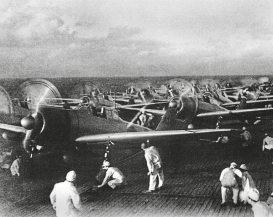

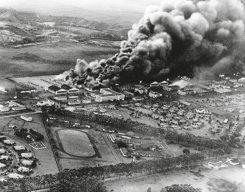






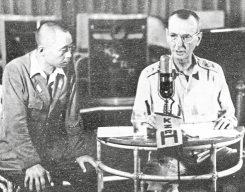







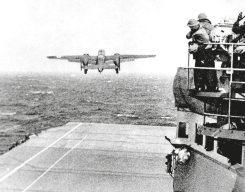




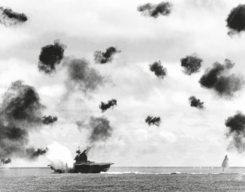








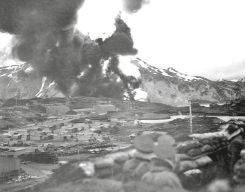




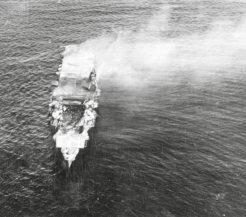




Soldiers of Japan’sImperial Army arepictured in Korea during the conflict with Russia. The country’sforces were nowamatchfor any major worldpower ✪

The Pacific Theatre
Whilethe world’sattention was fixated on events in Europe during the1920s and1930s, afierce andincreasinglybitterrivalry was growingbetween theUnitedStates andJapan as eachtried to dominatethe Pacificregion.
TheEuropeansituation was primarily political– theaftermath of theFirst World Warproviding idealconditions forthe growth of aggressive extremistviews –but thesituation in thePacifichad moreto do with economics. Conflicting US and Japanese interestscentred on theirmutually exclusivedesire to controland exploit the region’s abundant naturalresources rather than ideological differences.
When hostilitiesbetween thetwo nations dideventuallybreak out, theensuing clash wouldrankamong themostcatastrophic andbrutalinhistory.Itwas theoutcome of adecades-longdeterioration of relations; theresultingdevastation areflection of the extendedperiodduringwhich America andJapan had postured andprovoked one another.
It is almostimpossibletopinpointan exactdatewhenrelationsbetween thetwo countries begantosour. Certainlythere were clearwarning signs–suchas Japanese aggression in Chinainthe early1930s –butthe rivalryhad been established much earlierand was morerootedinwhat the twonationshad in common
They had each undergone adramatic transformation from insularand awkward to modern,industrialised, nationalistic andmilitaristic.
Before the1900s,there appeared to be little threat of a breakdownofrelations across thePacificOcean,but the respectiveactions of theUSand Japanduringthattime sowedthe seedsfor thegrand battle whichwas to come…
Thefoundationsfor future conflict
Both of them couldberegardedas‘new’ countries lookingtoestablish themselves. Neitherwas lackinginhistory –America had seenEuropeancolonists displacing the pre-existing native population andJapan had traditions stretchingbackcenturies –butneither had really existedasaunified nation strong enough to make itspresence felt on theworld stage.
Forbothcountries,thischanged in the earlytomiddlepartofthe 19th centuryas technological advances brought aboutan industrial revolution.The invention of new machines brought aboutsweeping changes –agriculture required fewerworkersand thepeoplewho were displacedwenttowork in city-basedfactories instead. As thecities grew,the process of sweeping away theold establishedorder began.
This economicand societal change was precipitatedpolitically in Americabyits declarationofindependencefromGreat Britainin1776and thesubsequent victory of American forces in therevolutionary war, twoeventsthat gave birthtoanew entity –the United States of America. Thesituation was mirrored in Japanby theMeiji Restoration; theinstigators of this movement fearfulofthe country’s
vulnerabilitytoaggressiveactionsby European powers andintentonseeing Japancatch up.Itwas from thebeginning of this period in 1868 that theEmpireof Japanarose
Theleaders of thetwo reborn societies putinplace governmental systemsand social structures that differed dramatically from one another, butessentially each had thesamecorepurpose –toassume complete controlofits owndestiny and ensure that it wouldnever have to bowto European demands.
With therapidgrowthofmanufacturing industryinthe twonations came theneed forraw materialsand newmarkets in which to sell theresultingproducts. Both countries begantolay thegroundwork for theirown ‘economic empires’.Theywere initially less concernedwiththe acquisition of land,thanwithsecuringunfettered access to lucrativetrade dealsthat were up forgrabs in Asia,Australiaand throughout thePacific.
In America, thedescendants of theoriginal European settlers spreadout across the continent, eventually reaching thePacific coastlineinnumbers.The naturalbarrier of thewater wouldnot stop theexpansion,

8PacificWar CHAPTER 1
however, andbeforelongthe US wouldset itssightsonexertinginfluencebeyond its borders. To thoseinpower it seemedasif thebestway to preventany entanglement in European affairswas forAmerica to claim it’s own‘sphere of influence’which,itwas decided, included allofthe Americas.
It mighthavebeenanearcentury-long process,but theappetitefor advancement andeconomic growth was toogreat forthe US to stop thereand followinga briefmilitaryengagement with Spainin 1898 it nowfound itself in possession of territoriesinthe Caribbean– andmore significantly outtothe west in thePacific. This move brought Americaface-to-face with theEmpireofJapan,itselfintenton establishing itsown area of influence in the areasimmediately surroundingits natural borders, andalsopursuinga strategy of economic freedom andprosperity.
At theturnofthe century, US and Japanese interestswereactuallyaligned andthere were many instancesofcooperationbetween thepair. Both countries supportedthe ideaofan‘open door’policy toward Chinathat wouldallow access to itsresource-rich regionsfor tradingand potentialinvestment, andasaresult US president Theodore Rooseveltacted as peacemaker in thenegotiations which spawned TheTreatyofPortsmouth– an agreementbetween Russia andJapan that
TheTreatyofPortsmouth
Oneofthe westernnationsthatJapan challengedinits efforts to establishitselfasa worldpowerwas Russia.By1904the twohad gone through severalyears of disputes over control of Manchuria –aregionofChina with great economicpotentialand an area that wouldprove to be apivotal zone in the Pacific Theatre.
The Russianshad enteredManchuriaduring thefirstSino-JapaneseWar of 1894-1895–a conflictbetween Japan andChina’s Qing Empire primarilyconcerningcontroloverKorea –and it’d been joinedbyGermanyand France as part of a‘triple intervention’thatsoughtto limit Japan’s abilitytocapitalisefinanciallyon itsclose proximitytothe territory, forcing it to give up control of portsthere

Oneofthose wasPortArthur,a warm-water facilitywithhuge commercial andstrategic attributes.Committedtobreaking free from theyokeofEuropeancontrol,Japan attacked theRussianfleetstationedthere in 1904 in asurpriseattackand forced an early victory. Throughout thenextyearthe twocountries’ armedforces clashedrepeatedlyand while it was Japanthatmanagedtorackupmost victories, they came at an unprecedented costwithcasualtiesonboth sides in thetens of thousands and theseverelossofmilitary equipment, including prizedships
Shortitmay have been, butthe warhad twosignificant outcomes. Thefirstwas the dramatic revelation to theworld thatthe JapaneseEmpire –acountrythatjusta half-








formally endedwar betweenthe twoin 1905.Japan’s apparentcommitmenttoequal opportunitywithregardtotrade in China meantAmericanpublicand politicalopinion swayed in favour of Japan.
Thebrokering of thetreatyprovedto be thefinalsignificantact of US-Japanese
century before had beenrelatively obscure and unengagedwithglobal events –had become apowerful militaryoutfit with tremendous capabilities andresources.Second, as with America’swar with Spain, it showed that Japanwould gotowhatever lengths necessary to protect itseconomicinterestsoverseas; in fact,considering thelossesitsuffered,it demonstratedthatitwas willingtogofar further than theUSinthisregard.
Thoselosses, however,did eventually begin to tell on Japan –and it becameapparent that thestrain of war wasgreater than anypotential victoryitcould achieve. Thesituation was likewise in Russia, and in 1905 both countries soughta negotiatedend to theviolence.



Japan invitedPresident Roosevelttooversee proceedings,and he welcomed representatives of both nations to Portsmouth, NewHampshire laterinthe year to begin peacetalks.
Roosevelthad actually beenbuoyed by Japan’s military success– theemphatic statementthatthe time of European domination waswelland trulyatanend being something he andall Americans couldsupport. He was,however,cautiousofManchuriafalling into totalJapanesecontrol andso– with his owninterests in mind –aimed to concludea dealthatmaintained abalance of powerand equal opportunityfor trade not just for Russia and Japan, butAmerica also.
Jurisdiction over theports of Manchuria was acentral component of thetalks, as were potentialreparations andfuture ownership of
co-operation before theoutbreakofwar in thePacific, however, andsubsequent yearswould seeanever-growing series of disagreements andconfrontations centred around theirrespective interestsinthe territoriesofthe Pacificand tradeaccess to SoutheastAsia
Apostcardissued shortly after the deal was agreed shows the main signatories of the Treaty of Portsmouth. ✪

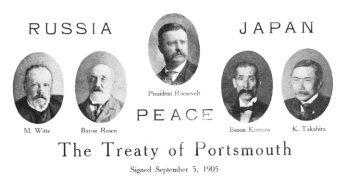
Sakhalin Island –alargeterritoryoff Japan’s northern coast. Neither side budged initially, butboth knew they lacked theresources andfinancestosustain furtherhostilities so eventuallycametoacompromisethatsaw Russianinfluencecurtailed in Manchuria andKorea, but retentionofcontrol over thenorthern part of Sakhalin Island and no requirement to payanindemnity to the enemy. Theagreementwas ratifiedasthe Treaty of Portsmouth.
Rooseveltwon aNobel peaceprize for his roleinthe talksand,while they did succeed in establishing détente, Japan andRussia had reason to resent theoutcome having not managedtoachieve all of theirrespective aims.Attention in Russiawould soon turn to thegrowing escalation of tensioninEurope, butfor Japanexpansion in Manchuria, China and beyond into thePacificbecame an evermore tantalisingproposition.Itwas arisky strategy,and it put thenationona collision course with theUnited States.
AJapanese print shows the country’ssuccessful assault on Port Arthur.The battle wasone of the first major demonstrations of Japan’snew navalstrength. ✪
Pacific War9
On the road to war
Rivaleconomicand territorial ambitionslaidthe foundationfor thePacific War, andChina wouldbethe settingfor theopeningact of theepicand devastating dramaabout to ensue…
WhileJapan had to re-evaluate itstactics in thewakeofits expensiveconflict with Russia,its strategy of extendingits influence across Asia remained unaltered. To furtherdevelop as an international poweritbecameclear to Japanese leadersthat thecountry needed adeepereconomyand greaterpoolof resourcestocallupon.
Thesamethoughtswereforming across thePacificinAmerica whereTheodore Roosevelt’sadministration had significantly expandedUSinterests overseas in the name of cash andasset generation.The fact that thetwo had competingaimscaused concernonbothsides of theocean,and thecontrasting ways in which they went aboutachievingthemwould become the cornerstone of thetensions betweenthe twothatwould eventually lead to war.
Newcentury,new worldpowers
Forthe US,expansion was pursuedby diplomaticmeans andthrough supportfor itsburgeoningcapitalist business sector. Maintainingits isolationisttendencies, centralgovernmentrefrained from direct involvement in international affairs– butdid whatitcould to promoteAmericanbusiness interestsabroad,often wading into murky waters as it used variousmeans andbackchannels to manipulate foreignaffairs
Twonotable examples of this were in Hawaii,where American government representativeshad encouraged andeven orchestrated elements of acoupd’état againstthe Hawaiian royalfamilythat wouldeventuallyresult in US annexation of theterritory;and in Colombian-controlled Panama,where President Roosevelt –afterhis plansfor achannel linkingthe Atlanticand Pacificwererejectedbythe Colombiansenate–activelysupported Panamanian rebels in theirefforts to declareindependence. Once this had been achieved,the US purchasedcontrol of the Panama CanalZone for$10 million and Roosevelt’swaterwaywas built.
It was adifferent storyinJapan.While theAmericannationhad been builtona
complexpolitical foundation that promoted itsthree branches of government –complete with checks andbalances–moreancient traditions ranthrough thenew Empire of Japanwhich gave ahighlevel of controlto itsemperor andalsoplacedanenormous amount of autocraticpower within the differentstrands of itsmilitary.
Whilethe US continuedwithits diplomacy –and itsmoresubversive tactics–Japan was farmoretransparent andwas not afraid to usemilitarymight to forcethrough itsaims. With theTreaty of Portsmouth having negatedRussian influence in thearea, in theearly 20th centuryJapan pushed theboundariesofits agreements with Americaregarding free enterprise in Chinabyconsolidatingits position in Manchuria.

Although tensions wouldboiloverinto otherissues–institutional discrimination againstJapanese-American immigrants on thewestcoast of theUnitedStates beingone of themajor examples –itwas Manchuria, andwider problems in China, which proved to be acontinuous sticking point. Theoutbreakofwar in Europe in 1914 meanta temporarycessation of diplomatic

The rise of the Imperial Japanese Navy rise of the








10 Pacific War CHAPTER 2
A Holland 1-class submarine,the first ever Japanese sub, that waspurchased during the Russo-Japanese War. ✪
The Japanese seaplane carrier Wakamiya –itwas from this ship that the world’sfirst sea-launched air raids originated in 1914. ✪
Hosho,the world’sfirstpurpose-built aircraft carrier,completed in 1922. ✪
In 1905 the Imperial Japanese Navy began building the battleship Satsuma,atthe time the largest warship in the world. ✪
back-and-forth as both Americaand Japan sidedwiththe EntentePowersagainst Germany–Japan providingmilitarysupport in Asia.However,muchtoAmerica’s dismay,Japan used thewar to extend its enterprisesinChina whilethe Imperial Japanese Navy –which hadbecomeanearautonomousinstitution in Japan’spolitical andmilitaryset-up–pushedout into the Pacificand wrestled various island groups from German hands.
By theend of theconflict therewas no doubtthat Japanhad become oneofthe leadingworld powers,and played akey role in postwarnegotiations andsettlements as one of thebrokers of theVersaillespeace treaty anda founding member of theLeague of Nations. Japan’semergence wasn’t necessarily viewed as an out-and-outthreat in theUS– butthe increasing frequency of itsendeavours in Chinaand further afieldcausedalarm,asdid thefrightening capability of itsnavy, which was nowone of themostadvancedinthe worldand had been utilised to devastatingeffectagainst Russia in 1904 andGermany throughout 1914-1918. Thefailure of postwartreatiesto quell fearsofanotherEuropeanwar andthe ever-increasing scopeand powerofJapan’s military over itsforeign affairsapproach were furtherareas of concern.
In response,USSecretaryofState Charles EvansHughesinvited Japanand sevenother nations to Washington in 1921 with two primaryaims: striking an agreementon howeachwould pursue itspoliciesinEast Asia,and reaching an accord on naval disarmamentand limitations.The meeting–andsubsequent gatherings in 1922 –became knownasthe Washington NavalConference.

Therewerethree majortreatiesagreed at theconference,and althoughtheywould ultimately fall shortoftheir goal to prevent tensionsbetween Japanand America evolving into war,their implementation did manage to uphold andmaintainastatusquo in Asia andthe Pacificfor thebestpartof thenextdecade.
AJapanese lithograph that historians believe showsthe Imperial Japanese Army fightingGerman troops in the German colonyofTsingtao during the First WorldWar.The original caption locates the action as being in Siberia after 1918, but there’snoevidence of German soldiers being in Asia during this time

Treaties of theWashington NavalConference
TheFive-PowerTreaty
Signed by theUS, Great Britain, Japan, France andItaly
This wasthe centrepieceagreementand called for thesignatories to maintain aset ratioofwarship tonnage –America andBritain allowed500,000 tons,Japan 300,000 tons and France andItaly 175,000tons; thenumbers reflectingthe fact thatthe US andUKhad to maintain fleetsinboth theAtlantic andPacific. Thenations also had to scrap older vesselsand they were preventedfrombuilding newcapital ships.Whilethe system was widely regarded as asuccess,the tonnagecontrolsdidn’t cover certain classes and so prompted anew race to build cruisers. Aside from itshardware restrictions,the treatyalso recognised American, Britishand Japanesebases in the Pacific butoutlawedany expansion
TheFour-Power Treaty
Signed by theUS, Great Britain,Japan and France
Thecountriesagreed to consult with each otherinthe eventofafuture crisis in East Asia before taking unilateral action.The strength of Japan’s military andits abilitytoact quickly in theregionwerekey factorsinthispartof theagreement, as wasthe need to replace the1902Anglo-JapaneseTreaty–American policymakersfearing thatif warwithJapan were to occur then Britain wouldbeobligated to sidewiththe Japanese. Thetreaty ensured thatnoneofthemwerecommitted to involvementinany argumentorconfrontation betweenother members, butput in placea mechanismthatwould hopefullydefuse any incidentand preventitfromdevelopinginto full-scale military action
TheNine-PowerTreaty
Signedbythe US,Great Britain, Japan, France,Italy, Belgium,the Netherlands, Portugal andChina
The final agreementofthe conferences formalised America’slong-held ‘opendoor’ approach to China andguaranteed thatall nationswould have an equal chancetodo business there.The treatydid recognise JapanesedominanceofManchuria, butalso reaffirmed China’sterritorialintegrity–akey elementthatwas designed to endJapanese expansion.For itspart, China agreed notto discriminate againstany countryseeking commercial opportunity.Aswould later become apparent,the one major flawwas thatitcalled for furtherconsultation in response to anyviolation andso lacked amethodbywhich to enforceits rules



















Pacific War 11
War11
The Washington NavalConference of 1921. ✪
Theinterwar years
TheWashingtonNaval Conference –along with thecomplex web of additional treaties andagreementsdesigned to settle the issues which prompted theFirst World War andprevent arepeat– managedtoupholda relatively peacefulstatusacrossthe globein the1920s,but troublewas brewing. Conflict had been costly –particularlyfor thelosing sides–and many European economieswent throughperiods of desperatestruggle.
It was thesamestory in Japanwhere, despiteits lightindustryhavingestablished itsplace in theworld market as aresult of thewar,its economywentintorecession in 1926. Thecircumstances were slightly differentinthe US –and thedecline would come alittlelater –but it wasn’timmune andeventhoughithad enjoyedarelative boom in itseconomyinthe early1920s it meantmanyofits citizenshad the opportunitytoborrow; andtheydid so to invest in thestock market.Itwas a houseofcards waitingtocollapse, and it didonTuesday,October 29,1929with theWallStreetCrash andthe onset of thedebilitatingGreat Depression

It meantthat the1930s beganwith global economic turmoil, anditwas an environmentthat sparkedawaveof nationalism andmilitaristictendencies across some of theworld’s superpowers–most notablyinGermany,Italy andJapan. TheactionsofGermany andItaly were of immediatethreattoEurope, andthe US –concentratingonits ownfinancialrecovery –heldtruetoits principles that it wouldnot entangle itself in affairsonthe othersideof theAtlantic. Westwardsacrossthe Pacific, however, Americahad aproblem
Japanese strength layinits manufacturingprowess andindustrial capability,but as ageographicallysmall nation it lacked thehugequantityof rawmaterials it needed andsobecame

dependent on western supplies.With politicalinstability andeconomic pressure creating unrest in thecountry,a militarist faction –led by army generalHidekiTojo, a member of Japan’sfascist party–was able to assume largeswathes of powerwithin thecountry’s corridors of power. Tojo,and othermilitaryleaders underthe direction of Emperor Hirohito,refocused attentionon expansioninEastAsiawhere thenecessary resourceswereplentiful andfar cheaper to come by.Pressurewas building,and it resulted in an eventthat couldbeargued as beingthe first military engagement of thePacificWar –the Mukden Incident
Manchuriahad been ahotspot for international wranglingfor many years, and on September18, 1931,asmall explosion occurred on aJapanese-ownedrailway line in theregion.Damagewas negligible –so muchsothat apassingtrain justminutes laterwas unimpeded– butthe Imperial Japanese Army blamed Chinesenationalists forthe ‘attack’and used it as apretextto invade.Untrained andill-equippedChinese forces coulddolittle, andJapan achieved full occupation of Manchuriawithout difficultyoropposition. Theidentityofthe ‘attackers’remains controversialtoday –evidencesuggestingthat theact was carriedout by Japanese military officers intent on provoking aggravation,looking for areasonto flextheir muscles andwanting an excuse to take controlofthe region

12 Pacific War
Asoldier raises the Japanese Empire’sflag abovea captured Chinese army building in Mukden the dayafter it movedintothe city ✪
Japanese forces disarm surrendering Chinese personnel following the occupationofManchuria and theestablishment of Manchuko ✪
Thefreedom enjoyedbyJapan’s military branches certainlymakes this theory a viable one, andit’ssupported by thefact that back in Tokyothere was shockathow farJapan’s aggression had gone.WithArmy andNavyleaders holdingconstitutional powerinJapan’s government,however, they were able to forcethrough theiraims –which also had supportfromthe people –and politicianswerepowerless to stop theinvadingforcesfromclaimingvictory aftervictory in theChinese townsand cities alongthe 730-mile long stretch of railway.
Whetherthe Mukden Incident wasan ill-advisedact of aggression by Chinese nationalistsora carefully orchestrated plan by theJapanesemilitaryasaprecursor forinvasion,Japan’s relentless march throughManchuria wouldnot be stopped. Within just afew months they hadassumed completecontrol andhad createdan autonomousstate in theregioncalled Manchuko that they controlled with a puppet government.
Andthe events in Manchuriawerejust thebeginningasthe over-zealous Japanese military wouldnot be confinedtoits initial expansion andinJanuary 1932 attacked theChinese city of Shanghai.Intenton establishing self-reliance, themilitaryonce againrespondedtoanincident–the beating of fiveJapaneseBuddhist monksand the burningdownofaJapanesefactory –with overwhelming forceassome30ships, 40 aircraft andnearly7000 troops were concentrated around Shanghai’s coastline. Anotheroccupation appeared imminent
There is evidence to suggestthat,like theMukdenaffair, Japan’smilitarywas behind theattackonthe monksand the destruction of thefactory,givingthem ‘just’ causetolay siegetoShanghai. At first Japanissuedanultimatum to the Shanghai MunicipalCouncil anddemanded public condemnation of thebeatings,
Chinese soldiers of the 19th Route Army guarda roadblock during Japan’s1932 offensiveinShanghai. ✪



compensation forpropertydamageand visibleaction to suppressanti-Japanese riots that hadbrokenout in theaftermath
Thecityauthorities had little option buttoagree to thedemands,but –because of thefractured natureofthe Chinese politicalstructure at thetime– its19th RouteArmyhad alreadymassedoutside thecity, causingconsternation among Shanghai’s officials andthe foreignpowers that hadtrade intereststhere.The move played straight into Japanese hands;aircraft from itspowerfulcarrier fleetbegan a bombingcampaigninresponseand 3000 troops quicklyspreadthrough theChinesecontrolled areasofthe city.Itwas morethan twomonthsbeforeChina andJapan signed theShanghaiCeasefire Agreement, and when it came it only served to putJapanese expansiononholdratherthanhavingany powertoscale it back.
Whilethe peace wouldlastfor five years, it was acombustible situation with
Japanintentonexpansion,China unable to preventitand Japanese military leadersin theregionenjoyingfar-reaching executive powers overthe forces at theircommand. On thenight of July 7, 1937,the two opposing forces wouldcomeface-to-face on Lugou, or MarcoPolo, Bridge near Beijing andfor reasons that remainamystery therewereshots fired.Bothgovernments andinternationalrepresentativesmoved quicklytoprevent an escalation buttheir lack of authorityovertheir armedforces meantthere was little chance they could intervene. Thesituation spiralledout of controland within weeks fightinghad intensified into thesecond Sino-Japanese Warbetween Chinaand Japan. With its military nowevenmorepowerfulthanithad been at thetimeofthe Mukden Incident, Japanese soldiers sweptdownthe coastwith brutal consequences forChinesetroopsand civiliansalike andwithinsix months Japan occupied Beijing, Shanghai andNanjing.
Pacific War13
Troops of the Imperial Japanese Army gather outside Mukden on September 18, 1931. ✪
RIGHT:Japanese anti-aircraft gunners watchthe skies overShanghai. Japan’sImperial Army wasmuchbetter equipped than the Chinese and its greater strength resulted in aseriesofswift victories ✪





















 By Jack Harrison
By Jack Harrison



































































































